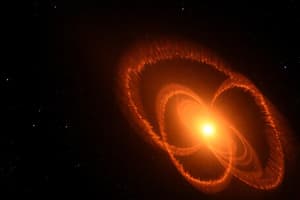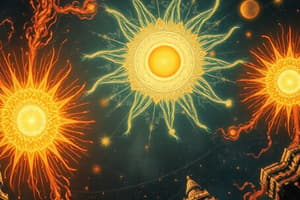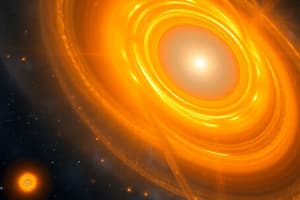Podcast
Questions and Answers
What is the most significant impact of Tak Wah Mak's discovery regarding T-cell receptors?
What is the most significant impact of Tak Wah Mak's discovery regarding T-cell receptors?
- It identified the specific antigens that provoke the body’s immune response.
- It demonstrated the applicability of molecular techniques in biological research.
- It elucidated the process by which T-cells are produced in the thymus gland.
- It provided a new avenue for understanding and treating diseases related to the immune system. (correct)
Tak Wah Mak's research addressed which fundamental question in immunology?
Tak Wah Mak's research addressed which fundamental question in immunology?
- The genetic origin of immune system disorders.
- The specific types of antigens that activate the immune system.
- The mechanism of T-cell production within the thymus gland.
- How T-cell receptors recognize and bind to antigens. (correct)
What methodological approach did Tak Wah Mak utilize to further explore immune responses to cancer?
What methodological approach did Tak Wah Mak utilize to further explore immune responses to cancer?
- He applied molecular techniques to study immune responses. (correct)
- He performed statistical analyses of patient data to identify correlations between genetic markers and cancer progression.
- He employed traditional cell culture techniques to observe T-cell behavior.
- He conducted in vivo experiments to test the efficacy of novel drugs.
Which statement best describes the significance of Mak's identification of the unique characteristics of T-cell receptor genes?
Which statement best describes the significance of Mak's identification of the unique characteristics of T-cell receptor genes?
Which of the following timelines accurately reflects Tak Wah Mak's key academic achievements?
Which of the following timelines accurately reflects Tak Wah Mak's key academic achievements?
What was the primary role of Jocelyn Bell Burnell in the discovery of pulsars?
What was the primary role of Jocelyn Bell Burnell in the discovery of pulsars?
Why was the discovery of pulsars significant in the field of astrophysics?
Why was the discovery of pulsars significant in the field of astrophysics?
What was the initial, informal designation given to pulsars by Jocelyn Bell Burnell?
What was the initial, informal designation given to pulsars by Jocelyn Bell Burnell?
What was Tak Wah Mak's key contribution to understanding the immune system?
What was Tak Wah Mak's key contribution to understanding the immune system?
How did Tak Wah Mak apply his research findings to cancer treatment?
How did Tak Wah Mak apply his research findings to cancer treatment?
What specific breakthrough did Tak Wah Mak achieve in the treatment of Hodgkin's lymphoma?
What specific breakthrough did Tak Wah Mak achieve in the treatment of Hodgkin's lymphoma?
What factor primarily influenced Jocelyn Bell Burnell to pursue a career in astronomy?
What factor primarily influenced Jocelyn Bell Burnell to pursue a career in astronomy?
What underlying principle connects Jocelyn Bell Burnell's discovery of pulsars with Tak Wah Mak's research on T-cells?
What underlying principle connects Jocelyn Bell Burnell's discovery of pulsars with Tak Wah Mak's research on T-cells?
Flashcards
T-cells
T-cells
A type of white blood cell produced by the thymus gland, crucial for immune response.
Antigens
Antigens
Substances that trigger the body’s immune response.
T-cell Receptors
T-cell Receptors
Receptors on T-cells that recognize antigens.
Unique T-cell Receptor Genes
Unique T-cell Receptor Genes
Signup and view all the flashcards
Molecular Immunology
Molecular Immunology
Signup and view all the flashcards
Jocelyn Bell Burnell
Jocelyn Bell Burnell
Signup and view all the flashcards
Pulsar
Pulsar
Signup and view all the flashcards
Pulsar Discovery
Pulsar Discovery
Signup and view all the flashcards
LGM-1
LGM-1
Signup and view all the flashcards
Tak Wah Mak
Tak Wah Mak
Signup and view all the flashcards
T-Cell Finding
T-Cell Finding
Signup and view all the flashcards
Targeted Treatment
Targeted Treatment
Signup and view all the flashcards
Study Notes
Jocelyn Bell Burnell
- Born in Belfast, Northern Ireland, she demonstrated a knack for science during her time at boarding school.
- Resolved to pursue astronomy as a teenager.
- Graduated from Glasgow University in 1965.
- Began her PhD thesis at Cambridge University, focusing on twinkling quasars.
- Under Antony Hewish's supervision, she aided in constructing an array of radio telescopes for detecting quasars.
- In November 1967, she detected unusual signals: radio waves pulsating every 1.337 seconds from a fixed spatial point.
- Over the next two months, similar signals were found in other regions of space.
- Determined, with Hewish, that the radio waves originated from the radiation beam of a rapidly rotating, strongly magnetized neutron star.
- Each rotation caused a "pulse," leading to the name "pulsar" for this new type of star.
- She initially named the signals LGM-1 (Little Green Men-1) due to their precise nature.
- The term "pulsar" was officially adopted in 1968.
- In 1967, she observed a pulsar, and Antony Hewish reported her discovery in a Nature article in 1968.
- Although not named in the award herself, her supervisor received the Nobel Prize in Physics in 1974.
- Made a Dame Commander of the British Empire (DBE) in 2007 for her contributions to astronomy.
Tak Wah Mak
- Immunologist and molecular biologist who discovered how T-cells recognize antigens.
- He advanced molecular comprehension of cancer cells.
- Born in southern China in 1946.
- He spent his childhood in Hong Kong before moving to the US with his family.
- Studied at the University of Wisconsin.
- In 1968, he earned a PhD in biochemistry from the University of Alberta, Canada.
- Mak's T-cell research solved an immunological problem, uncovering how T-cell receptors recognize antigens.
- His 1983 discovery revealed that T-cell receptor genes have a distinct genetic sequence and origin.
- Applied molecular techniques to explore immune responses to cancer.
- In 1972, following completion of his doctorate, he accepted a fellowship at the Ontario Cancer Institute
- In March 1984, the Nature journal published the details the genetic encoding of human T-cell receptors
- He used experiments with mice to isolate genetic function for cancer and immunology studies in 1988.
- In 1999, he identified a chemical to block the fuel supply of Hodgkin’s lymphoma.
Studying That Suits You
Use AI to generate personalized quizzes and flashcards to suit your learning preferences.
Description
Jocelyn Bell Burnell discovered pulsars while working on her PhD at Cambridge University. Under Antony Hewish's supervision, she detected unusual radio signals. These signals were identified as radiation beams from rapidly rotating, strongly magnetized neutron stars, now known as pulsars.





